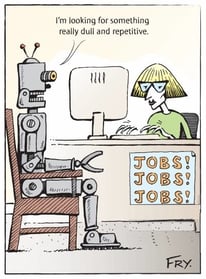By now it’s clear that businesses that execute on artificial intelligence (AI) successfully are the ones that will move from doing one-off analysis, and even one-off models, to being able to deftly manage hundreds (maybe even thousands) of models in production. And it should also be clear that the only avenue to that kind of scale is automation.

Yet it’s been about a year and a half since the term “Augmented Analytics” burst onto the scene, and the enterprise has been slower than expected to adopt this particular concept. Here’s just a few of the key reasons why companies should — nay, need — to put a bigger focus on automation in the new year to come.
It Takes the Robot Out of Humans
No one likes to do repetitive work that, quite frankly, probably should be done by a computer anyway. Not data analysts (who would rather spend their time getting their hands dirty in more interesting projects and developing their skills in more machine learning-based tasks), and certainly not data scientists (who, by nature, are curious people that did not get into the field to spend 80-ish percent of their time on data cleaning).

So if the business doesn’t want to lose key talent to boredom, moving toward automation at all steps of the data science process (gradually, of course) makes sense. After all, retaining data scientists and other data professionals in today’s market takes more than just cushy perks — these employees usually the pick of the litter when it comes to data jobs, especially if they’re good at what they do.
It’s the Only Path to Massive Scale
Entering the AI race without AutoML or augmented analytics would be like entering a driver into a Formula 1 Grand Prix without the right car and supporting team. Sure, you can do machine learning and eventually AI without it, but it will be much slower and less efficient, which inherently means trouble scaling.
Business intelligence (BI) was mostly about solving one single question one single time. Or one single question with one single dashboard. But how, in this world, would one go from one question to answering one million questions? Hire more people?

Think about what a data team could do if most of their time was suddenly free. No, it doesn’t mean everyone loses their jobs (for the last time, calm down, robots are not coming for everyone’s job). Instead, it means much more time to innovate — explore new use cases, take on new projects, reach out to new teams maybe not as essential to the core of the business) with data initiatives (like HR, often overlooked but a great opportunities for gain in using AI).
More Time for Transparency and Trust
It’s true that one major challenge to effectively leveraging AutoML and augmented analytics is that issues of model transparency and trust can fall by the wayside. But it’s also true that automating parts of the data process gives humans more time to think about these issues, check what’s happening, test, and ensure that policies around data trust and transparency are being respected. And this is one of the key issues that, really, only humans can solve.





